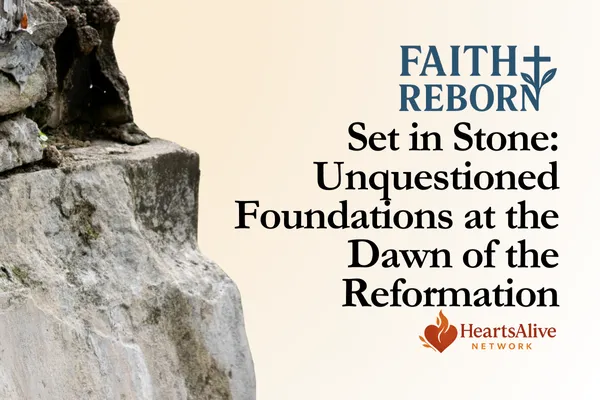
Set in Stone: Unquestioned Foundations at the Dawn of the Reformation
Paul once wrote, “No one can lay any foundation other than the one already laid, which is Jesus Christ” (1 Cor. 3:11). Yet by the dawn of the Reformation, many layers had been added to the foundation.
Over 15 centuries, layer by layer, translation by translation, philosophy by philosophy, assumptions had hardened into stone. The tragedy is that while Luther and the other Reformers stepped up to challenge the corruption of the church, they left most of these deeper foundations untouched.
Aiming at the Wrong Goal
The early Christian hope was the Kingdom of God coming to earth as in heaven. But under the influence of neo-Platonic thought, the goal shifted. Reality was split into two levels—heaven vs. earth, spirit vs. body. Salvation became less about renewal and more about escape.
Changing the Problem
With a new goal came a new diagnosis of the problem. No longer was sin understood as a covenant-breaking power that enslaves humanity and creation. Instead, it became a legal issue: dishonoring God and breaking divine laws. Roman legal categories framed sin in terms of guilt and offense.
This perspective was baked into the Latin Vulgate:
Metanoia (“change your mind”) became “do penance.”
Dikaiosyne (God’s covenant justice) became “righteousness,” a moral standard we achieve.
Hilasterion (the mercy seat) became “propitiation,” a payment to appease God.
Gehenna, Sheol, and Hades collapsed into “hell.”
Aionios (the age) became “eternity.”
Kolasis (discipline) became “eternal torment.”
Modifying the Solution
Once the problem was defined as offending God’s honor, the solution was cast in terms of satisfaction. A perfect sacrifice was required to balance the scales. By the Middle Ages, this logic gave rise to a system in which grace was mediated through the church—penance, indulgences, relics, and the authority of priests.
What the Reformers Saw—and What They Didn’t
By 1500, the corruption of this system was obvious. Luther and the Reformers rightly condemned indulgences and the abuse of priestly power. Their call of sola fide (“faith alone”) tore down the mediating role of the institutional church.
But the older foundations remained in place. The goal was still heaven, not new creation. The problem was still legal, not covenantal. The cross was still understood as satisfying God’s anger, later refined into penal substitution.
The Legacy of Untouched Foundations
Thus, by the close of the Reformation, the “gospel” had been solidified into this:
You sinned. God is angry. Jesus died so you can go to heaven instead of suffering eternal conscious torment in hell.
The corruption was challenged. The mediating priests were removed. But the deeper foundations—laid centuries earlier—remained unshaken.
Looking Back, Looking Ahead
Paul’s reminder echoes through history: “No one can lay any foundation other than the one already laid, which is Jesus Christ.”
In today’s season of deconstruction and reconstruction, it is essential that we examine these foundational—dare we say, fundamental—beliefs. If we do not return to Christ as the true foundation, we risk repeating the same mistakes of building on stone already laid by human hands.


